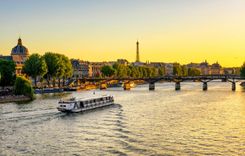5. Château des Pêcheurs, The Loire
Six miles northeast of Gien in La Bussière is a surprising château dedicated to fishing: the so-called Château des Pêcheurs.
Initially a fortress, the château was turned into a luxurious residence at the end of the sixteenth century, but only the gateway and one pepper-pot tower are recognizably medieval. Guided tours are available, but you’re free to wander around, soaking up the genteel atmosphere evoked by the handsome, largely nineteenth-century furnishings and the eccentrically huge collection of freshwater fishing memorabilia bequeathed by Count Henri de Chasseval.
How to get to Château des Pêcheurs
It’s easiest to drive to this France castle—take the D951 and D49 from Gien. There’s on-site parking. If you’re not driving, you could take a taxi from Gien’s train station. Renting a bike in Gien is another good option if you’re up for a scenic ride. The château is open March to November, with shorter hours in winter. Your ticket includes access to the garden.
6. Château de Tanlay, Burgundy
The romantic Château de Tanlay is a pleasant 4 mile (8 km) cycle along the canal southeast from Tonnerre. This early sixteenth-century construction, very French in feel, is only slightly later in date than its near neighbour, but those extra few years were enough for the purer Italian influences visible in Ancy to have become Frenchified.
Encircling the château are water-filled moats and standing guard over the entrance to the first grassy courtyard is the grand lodge, from where you enter the château across a stone drawbridge.
How to get to Château de Tanlay
The canal route from Tonnerre is an easy ride if you’ve got a bike. By car, just follow signs off the D965. There’s a limited bus to Tanlay village in the summer, but the easiest combo is to take the train from Paris to Tonnerre (about 2 hours), then bike or taxi the rest of the way. The château is open April through October.

















